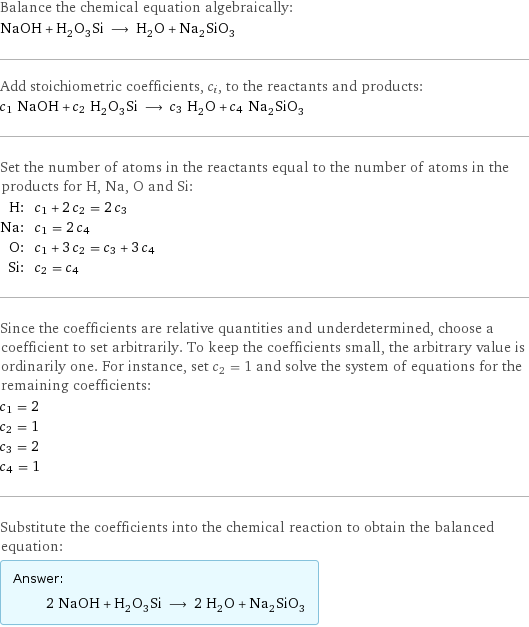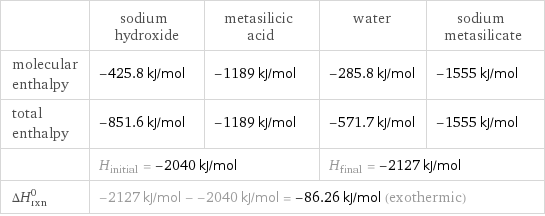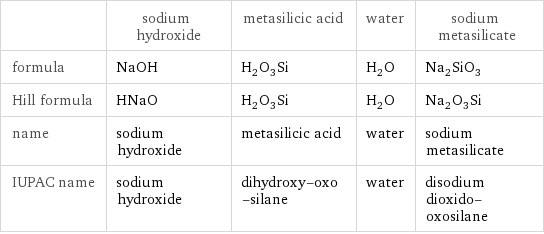Input interpretation

NaOH sodium hydroxide + H_2O_3Si metasilicic acid ⟶ H_2O water + Na_2SiO_3 sodium metasilicate
Balanced equation

Balance the chemical equation algebraically: NaOH + H_2O_3Si ⟶ H_2O + Na_2SiO_3 Add stoichiometric coefficients, c_i, to the reactants and products: c_1 NaOH + c_2 H_2O_3Si ⟶ c_3 H_2O + c_4 Na_2SiO_3 Set the number of atoms in the reactants equal to the number of atoms in the products for H, Na, O and Si: H: | c_1 + 2 c_2 = 2 c_3 Na: | c_1 = 2 c_4 O: | c_1 + 3 c_2 = c_3 + 3 c_4 Si: | c_2 = c_4 Since the coefficients are relative quantities and underdetermined, choose a coefficient to set arbitrarily. To keep the coefficients small, the arbitrary value is ordinarily one. For instance, set c_2 = 1 and solve the system of equations for the remaining coefficients: c_1 = 2 c_2 = 1 c_3 = 2 c_4 = 1 Substitute the coefficients into the chemical reaction to obtain the balanced equation: Answer: | | 2 NaOH + H_2O_3Si ⟶ 2 H_2O + Na_2SiO_3
Structures

+ ⟶ +
Names

sodium hydroxide + metasilicic acid ⟶ water + sodium metasilicate
Reaction thermodynamics
Enthalpy

| sodium hydroxide | metasilicic acid | water | sodium metasilicate molecular enthalpy | -425.8 kJ/mol | -1189 kJ/mol | -285.8 kJ/mol | -1555 kJ/mol total enthalpy | -851.6 kJ/mol | -1189 kJ/mol | -571.7 kJ/mol | -1555 kJ/mol | H_initial = -2040 kJ/mol | | H_final = -2127 kJ/mol | ΔH_rxn^0 | -2127 kJ/mol - -2040 kJ/mol = -86.26 kJ/mol (exothermic) | | |
Gibbs free energy

| sodium hydroxide | metasilicic acid | water | sodium metasilicate molecular free energy | -379.7 kJ/mol | -1092 kJ/mol | -237.1 kJ/mol | -14628 kJ/mol total free energy | -759.4 kJ/mol | -1092 kJ/mol | -474.2 kJ/mol | -14628 kJ/mol | G_initial = -1852 kJ/mol | | G_final = -15102 kJ/mol | ΔG_rxn^0 | -15102 kJ/mol - -1852 kJ/mol = -13250 kJ/mol (exergonic) | | |
Equilibrium constant
![Construct the equilibrium constant, K, expression for: NaOH + H_2O_3Si ⟶ H_2O + Na_2SiO_3 Plan: • Balance the chemical equation. • Determine the stoichiometric numbers. • Assemble the activity expression for each chemical species. • Use the activity expressions to build the equilibrium constant expression. Write the balanced chemical equation: 2 NaOH + H_2O_3Si ⟶ 2 H_2O + Na_2SiO_3 Assign stoichiometric numbers, ν_i, using the stoichiometric coefficients, c_i, from the balanced chemical equation in the following manner: ν_i = -c_i for reactants and ν_i = c_i for products: chemical species | c_i | ν_i NaOH | 2 | -2 H_2O_3Si | 1 | -1 H_2O | 2 | 2 Na_2SiO_3 | 1 | 1 Assemble the activity expressions accounting for the state of matter and ν_i: chemical species | c_i | ν_i | activity expression NaOH | 2 | -2 | ([NaOH])^(-2) H_2O_3Si | 1 | -1 | ([H2O3Si])^(-1) H_2O | 2 | 2 | ([H2O])^2 Na_2SiO_3 | 1 | 1 | [Na2SiO3] The equilibrium constant symbol in the concentration basis is: K_c Mulitply the activity expressions to arrive at the K_c expression: Answer: | | K_c = ([NaOH])^(-2) ([H2O3Si])^(-1) ([H2O])^2 [Na2SiO3] = (([H2O])^2 [Na2SiO3])/(([NaOH])^2 [H2O3Si])](../image_source/6f88532deb12b804cdd26be82d0b5e7d.png)
Construct the equilibrium constant, K, expression for: NaOH + H_2O_3Si ⟶ H_2O + Na_2SiO_3 Plan: • Balance the chemical equation. • Determine the stoichiometric numbers. • Assemble the activity expression for each chemical species. • Use the activity expressions to build the equilibrium constant expression. Write the balanced chemical equation: 2 NaOH + H_2O_3Si ⟶ 2 H_2O + Na_2SiO_3 Assign stoichiometric numbers, ν_i, using the stoichiometric coefficients, c_i, from the balanced chemical equation in the following manner: ν_i = -c_i for reactants and ν_i = c_i for products: chemical species | c_i | ν_i NaOH | 2 | -2 H_2O_3Si | 1 | -1 H_2O | 2 | 2 Na_2SiO_3 | 1 | 1 Assemble the activity expressions accounting for the state of matter and ν_i: chemical species | c_i | ν_i | activity expression NaOH | 2 | -2 | ([NaOH])^(-2) H_2O_3Si | 1 | -1 | ([H2O3Si])^(-1) H_2O | 2 | 2 | ([H2O])^2 Na_2SiO_3 | 1 | 1 | [Na2SiO3] The equilibrium constant symbol in the concentration basis is: K_c Mulitply the activity expressions to arrive at the K_c expression: Answer: | | K_c = ([NaOH])^(-2) ([H2O3Si])^(-1) ([H2O])^2 [Na2SiO3] = (([H2O])^2 [Na2SiO3])/(([NaOH])^2 [H2O3Si])
Rate of reaction
![Construct the rate of reaction expression for: NaOH + H_2O_3Si ⟶ H_2O + Na_2SiO_3 Plan: • Balance the chemical equation. • Determine the stoichiometric numbers. • Assemble the rate term for each chemical species. • Write the rate of reaction expression. Write the balanced chemical equation: 2 NaOH + H_2O_3Si ⟶ 2 H_2O + Na_2SiO_3 Assign stoichiometric numbers, ν_i, using the stoichiometric coefficients, c_i, from the balanced chemical equation in the following manner: ν_i = -c_i for reactants and ν_i = c_i for products: chemical species | c_i | ν_i NaOH | 2 | -2 H_2O_3Si | 1 | -1 H_2O | 2 | 2 Na_2SiO_3 | 1 | 1 The rate term for each chemical species, B_i, is 1/ν_i(Δ[B_i])/(Δt) where [B_i] is the amount concentration and t is time: chemical species | c_i | ν_i | rate term NaOH | 2 | -2 | -1/2 (Δ[NaOH])/(Δt) H_2O_3Si | 1 | -1 | -(Δ[H2O3Si])/(Δt) H_2O | 2 | 2 | 1/2 (Δ[H2O])/(Δt) Na_2SiO_3 | 1 | 1 | (Δ[Na2SiO3])/(Δt) (for infinitesimal rate of change, replace Δ with d) Set the rate terms equal to each other to arrive at the rate expression: Answer: | | rate = -1/2 (Δ[NaOH])/(Δt) = -(Δ[H2O3Si])/(Δt) = 1/2 (Δ[H2O])/(Δt) = (Δ[Na2SiO3])/(Δt) (assuming constant volume and no accumulation of intermediates or side products)](../image_source/3f2e38f6a6ad8fbe3ce74fc8a5b917d0.png)
Construct the rate of reaction expression for: NaOH + H_2O_3Si ⟶ H_2O + Na_2SiO_3 Plan: • Balance the chemical equation. • Determine the stoichiometric numbers. • Assemble the rate term for each chemical species. • Write the rate of reaction expression. Write the balanced chemical equation: 2 NaOH + H_2O_3Si ⟶ 2 H_2O + Na_2SiO_3 Assign stoichiometric numbers, ν_i, using the stoichiometric coefficients, c_i, from the balanced chemical equation in the following manner: ν_i = -c_i for reactants and ν_i = c_i for products: chemical species | c_i | ν_i NaOH | 2 | -2 H_2O_3Si | 1 | -1 H_2O | 2 | 2 Na_2SiO_3 | 1 | 1 The rate term for each chemical species, B_i, is 1/ν_i(Δ[B_i])/(Δt) where [B_i] is the amount concentration and t is time: chemical species | c_i | ν_i | rate term NaOH | 2 | -2 | -1/2 (Δ[NaOH])/(Δt) H_2O_3Si | 1 | -1 | -(Δ[H2O3Si])/(Δt) H_2O | 2 | 2 | 1/2 (Δ[H2O])/(Δt) Na_2SiO_3 | 1 | 1 | (Δ[Na2SiO3])/(Δt) (for infinitesimal rate of change, replace Δ with d) Set the rate terms equal to each other to arrive at the rate expression: Answer: | | rate = -1/2 (Δ[NaOH])/(Δt) = -(Δ[H2O3Si])/(Δt) = 1/2 (Δ[H2O])/(Δt) = (Δ[Na2SiO3])/(Δt) (assuming constant volume and no accumulation of intermediates or side products)
Chemical names and formulas

| sodium hydroxide | metasilicic acid | water | sodium metasilicate formula | NaOH | H_2O_3Si | H_2O | Na_2SiO_3 Hill formula | HNaO | H_2O_3Si | H_2O | Na_2O_3Si name | sodium hydroxide | metasilicic acid | water | sodium metasilicate IUPAC name | sodium hydroxide | dihydroxy-oxo-silane | water | disodium dioxido-oxosilane
Substance properties

| sodium hydroxide | metasilicic acid | water | sodium metasilicate molar mass | 39.997 g/mol | 78.098 g/mol | 18.015 g/mol | 122.06 g/mol phase | solid (at STP) | solid (at STP) | liquid (at STP) | solid (at STP) melting point | 323 °C | 1704 °C | 0 °C | 72.2 °C boiling point | 1390 °C | | 99.9839 °C | density | 2.13 g/cm^3 | 1 g/cm^3 | 1 g/cm^3 | 1.749 g/cm^3 solubility in water | soluble | | | soluble surface tension | 0.07435 N/m | | 0.0728 N/m | dynamic viscosity | 0.004 Pa s (at 350 °C) | | 8.9×10^-4 Pa s (at 25 °C) | 1 Pa s (at 1088 °C) odor | | | odorless |
Units
